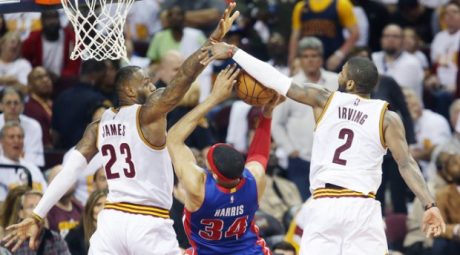
The Point Four-ward: James Says
2016-04-20
Four points I’m thinking about the Cleveland Cavaliers…
1.) Being LeBron James means having to deal with criticism. A lot of it. And while much of the criticism he receives is arguably unwarranted, it’s not like he’s always without culpability in the matter.
For instance, when King James praises King James’s own commitment to being a great leader, it’s fair to criticize when that leadership appears questionable.
Whether it was James browbeating a fragile Timofey Mozgov as he tried to work his way back from injury, his frequent moodiness, or his’s seductive (and often distracting) waltz with his social media outlets this season, the line between James’s ego and the clear mission of making those around him better wasn’t always a clear one.
The Cavs and their biggest star looked like they couldn’t get the regular season over quickly enough and their fans were left to hope that the team would look much better once they were locked in.
That’s why James’s Game 1 performance against the Pistons on Sunday might be one of my favorite LeBron performances in a while. The Cavs quickly found themselves down by seven points at the start of the fourth quarter. They desperately needed a shot — not someone who would win the game for them, but someone who would lead. That’s exactly what James did.
James has had better scoring games. He’s certainly had more memorable games. But on Sunday, James came out and played as smart and willful a game as I can remember him playing since last year’s playoffs.
Maybe I thinking this just because it was the most recent game — the most recent win — for the team. Or, maybe, it was because the team started playing with the kind of offensive balance that fans had been waiting for much of the last two years. Or, maybe, I was actually seeing James play a better, quieter game than in the past, a game that spilled over with enough confidence that his teammates were able to drink their share, as well.
2.) Take a look at the following two shot charts.
The first also comes from an opening game of the playoffs, this one part of a respectable 24 point outing on 9-19 shooting (not pictured: six rebound, five assists, four blocks and a team-leading +19).
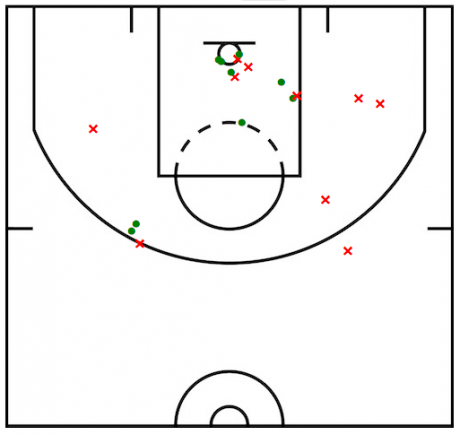
Now, compare that to this one:
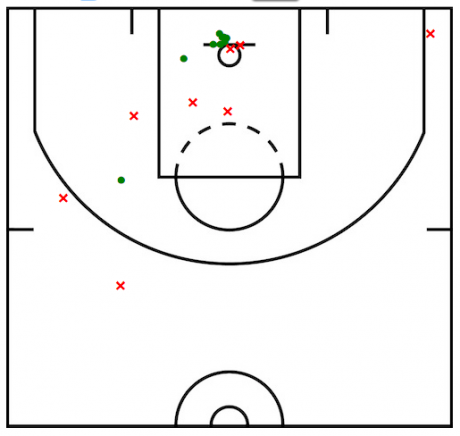
The player with this chart also led his team in +/- with +18 and logged 22 points on a very similar 9-17 shooting. This is, of course, the chart for James’s Game 1 against the Pistons. The first chart was his Game 1 against the Bulls in the 2010 Playoffs.
The differences between these two charts is subtle, but there is a difference there.
The second chart shows seven of the 17 shots taken at the rim and a total of nine of them in the painted area. Ten of his 19 shots in the 2010 opener also came in the paint. Of course, cutting through the teeth of the defense is nothing new for James. But eight of his makes on Sunday came at the rim, compared to just three in 2010. And, while he hit one more outside shot against the Bulls than he did against the Pistons, his shot selection seemed much more efficient and precise in 2016 than it was back in 2010.
3.) Okay, break out the caveats: I’m well aware that comparing James’s shooting in two games separated by six years isn’t the most scientific way to explain what I liked so much about Sunday’s performance. It’s not an entirely fair comparison… but it does show the efficiency — the lack of wasted energy — that characterized his play all afternoon. For the most part, he took the best shots he could create. When those shots weren’t there, he didn’t force it. He found the better shot that the Pistons defense was willing to give up to one of his teammates.
When LeBron got out on the break, still looked to attack the basket, as he does here:
With three other defenders between James and J.R. Smith at the three point line, James does the right thing and beats just one man (Marcus Morris) for the easy bucket.
James was also willing to move without the ball, as he does on this beautiful out of bounds play in the closing seconds of the first quarter:
Then, when the game was on the line, James looked to get his teammates going. We’ve all seen James try to bully his way to the rim (and, presumably, to the foul line) in these situations. But, here, James knew that his team’s ultimate success could depend on timely shots from role players like Richard Jefferson—
More importantly, though, he knew that Kevin Love playing with confidence makes this a much more dangerous team than they’ve showed for much of the time Love’s been on the floor in his two seasons here. Love hustled all game and James rewarded him with this open-look dagger in the fourth:
[Note: For more on LeBron’s recent stellar play, David broke it down in the current edition of The Wood Shop.]
4.) So, why does this feel different? Why does James’s pass to Love feel to similar passes to, say, Donyell Marshall, some of which have fallen, while others have famously not?
Part of it has to do with talent. For as unevenly as he’s played since donning the wine and gold, Love is a better player — especially in that situation — than Marshall. But a lot of it has to do with possibility, as well.
Cavs fans know that Playoff LeBron is still capable of extraordinary things. We saw what he was able to do in guiding an injury-depleted roster to Game 6 of the NBA Finals last year. What we haven’t seen yet — or have only seen in spurts and for stretches — is the level James can play at if the talent surrounding him also plays up to their abilities. He got help on Sunday, which meant that James didn’t have to primarily be a scorer. He could pass. He could defend. He could muck things up in the post. He could just be a basketball player — and he could not just do, he could lead.
The Cavs and their fans can only hope they get to see a lot more of LeBron James, the leader, as the playoffs continue.

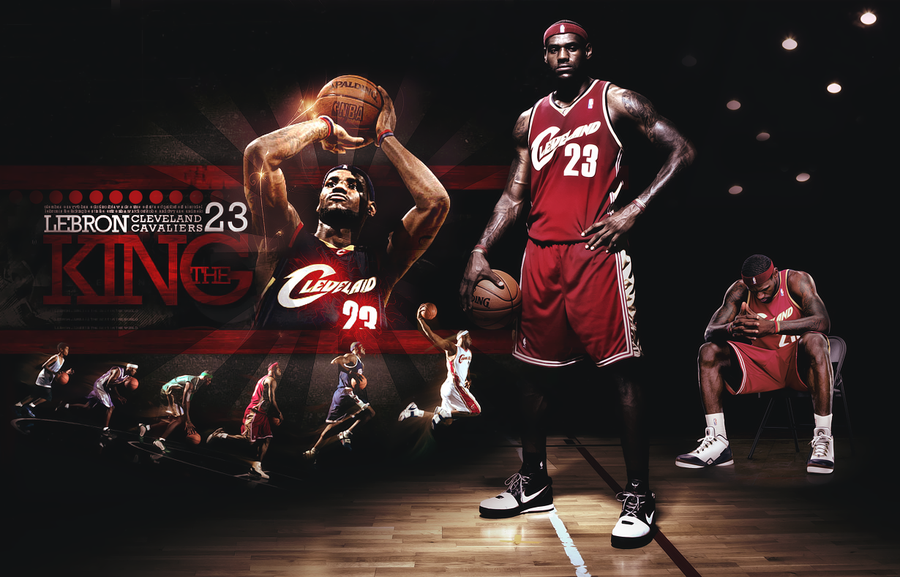
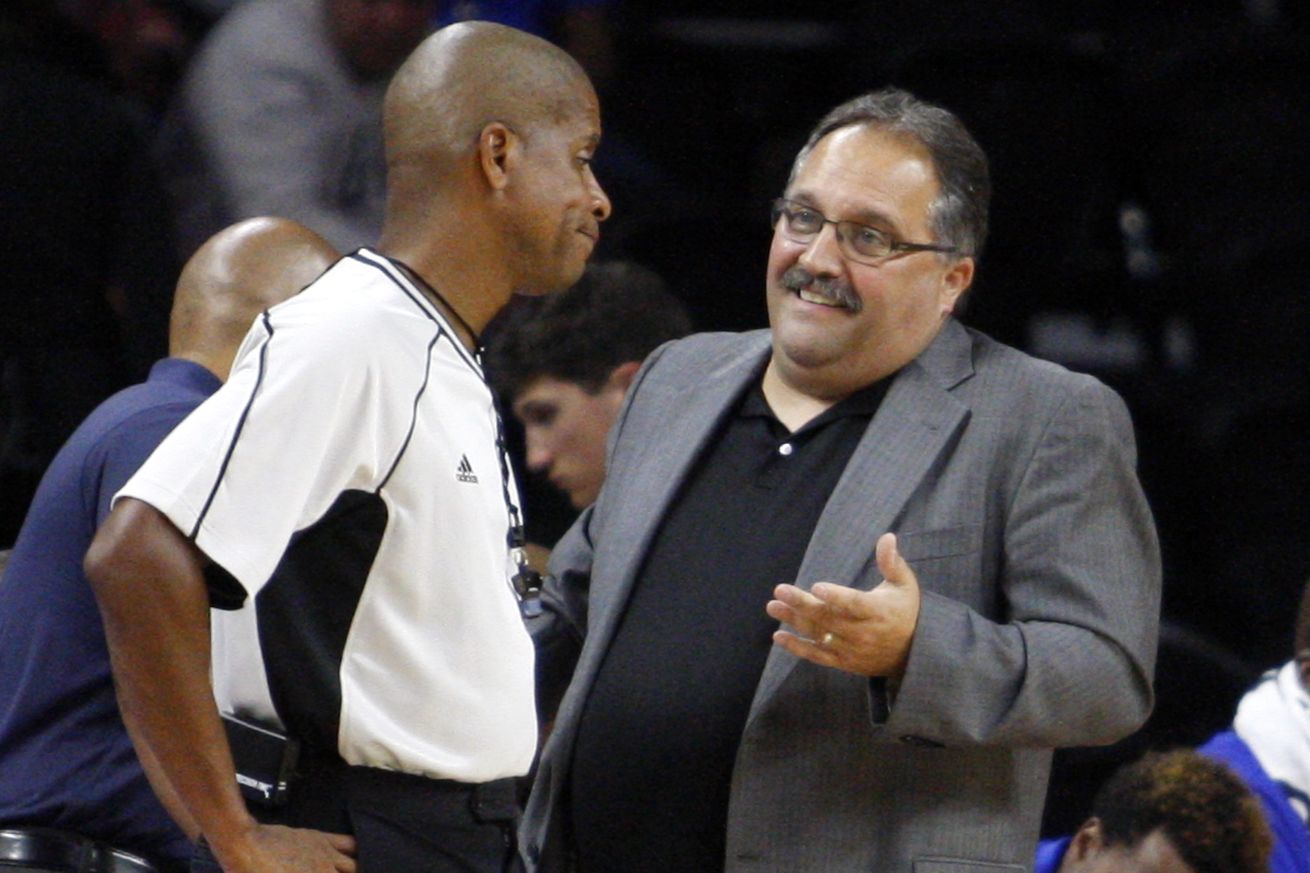
Great piece Robert!
Thibs to Minnesota should work out short term for them. Although I’d be worried after what happened in Chicago. You don’t want a team to go all out in the regular season only to get destroyed in the playoffs.
The big question is whether or not he can make Wiggins actually useful or if he’ll remain a bust.
Agree on all accounts. Thibs can retain his coaching philosophies but he needs to listen to the feedback of his players and maintain open communication with the front-office. Excited to see what he does with KAT.
Wiggins is a bust? You nonstop trolling is exhausting.
So far, yeah, he’s been awful. He’s a sieve on defense, he can’t shoot, he doesn’t rebound or pass well.
http://www.basketball-reference.com/players/w/wiggian01/gamelog/2016/#136-163-sum:pgl_basic
Since the ASB, 48%/41%/80% splits with 20 ppg scoring, and wins at golden state, charlotte, memphis, okc, Washington, and Portland . Oh, and he’s 21. Do you just say stupid things to start arguments? His defense has been very bad at times, but as you always said with Kyrie. He has plenty of time to learn how to defend.
Cols – you know I have been a Wiggins skeptic. But he has been shooting well since ASB. We’ll see if he regresses next year and keeps improving.
A bust is probably too much. But Wiggins is certainly underwhelming. He was supposed to be the next great generational player, and superstars usually exhibit greatness in their third year but there’s no sign of it coming from Wiggins this fall. He will be a glorified role player at best. Just doesn’t show the desire, the fire to win, the leadership skills. Completely disappears during whole stretches of a game.
Now KAT on the other hand. That’s a leader. That’s someone who could be a superstar.
And if this conversation is regarding the K-Love – Wiggins comparison…. what K-Love has shown in the first round of playoffs last year and so far this year (one game, I know) as well as the last month of this year’s season, it’s K-Love by a mile.
I wish the Cavs had Sergio Rodriguez or Sergio llul so that we could say, “James says… I’m done with Sergio!”
https://www.youtube.com/watch?v=43iW8oB20Ps
LOL… have you seen my wig around? I feel naked without it…
Blah, so long until the game starts! 6:00 pm is so far away.
Kevin Love is an undefeated playoff master.
I really enjoy highlights in the articles, thanks CtB!!!!!!!!!!!!!!!!!!!!
I moved to Detroit this year because of my job, and I have to say the people in Detroit are absolutely TERRIFIED of Kevin Love. For as much crap as he took all year, it’s basically anyone in this city can talk about. Kyrie is almost a total after thought. Most of the city feels like they don’t have much of a chance and I think a sweep is in order. I can’t wait to watch them finish the sweep in the Palace on Sunday!
I think they realize that Kevin Love is undefeated in the playoffs.
That is interesting! Love has come a long way from a year ago!! I hope he can keep up the intensity & skilled shooting!
I’m really sorry to hear you had to move to Detroit…
I love Boston getting swept again. They suck so bad. Someday people will learn that try hard teams suck in the playoffs, and Lebron lead teams get better in the playoffs. I’m not sure when that lesson will sink in.
I really don’t hate this Boston team that much compared to the Paul Pierce era. I can’t explain it. There is something appealing to this Brad Stevens guy taken a bunch of young bucks and improving them to get deeper into the playoff seeding. As much as I can’t stand Danny Ainge, I love he stuck with Stevens , allowed him to develop the team. They are the classic underdog story.
I hate them much more because they get all this media love and suck. They suck. They really suck. They are about to be 0-8 in the playoffs. Stevens gets out coached every playoffs.
You cannot win in the NBA with a collection of bench players. It’s just not possible..
I too get annoyed by the media love for Boston and Stevens. Its part of the new movement by feaux analytics types to overrate teams that play “team” ball, and, more generally, to place too much value on the style and/or aesthetics of play rather than the outcomes. The goal of basketball is to score as efficiently as possible, play defense, and win in the playoffs. By that criteria, Boston is not good.
I think part of that is because so many people in the national media are from Boston. Simmons is the obvious one, but there are a *lot* of guys in the sports/ talk radion media business who grew up Celtics fans. Most of them aren’t as obnoxious about it as Simmons, but still.
You realize your last statement contradicts your first, right? You can’t say he always gets outcoached, but that he loses because he has a team full of bench players.
So now we are blaming Lebron for Mozgov sucking? Great, just great.
EG, please find some kind of graphic to illustrate Cols inability to find middle ground. Implying that LeBron’s “leadership tactics” used on a struggling Mozgov may not have necessarily been effective is not BLAMING LeBron for Mozgov’s poor play. I forgot though, LeBron has no more room for improvement. He is, and always will be, perfect… /s
Blaiming LeBron even a bit for Mozgov being a terrible player this year is nuts.
Again, he wasn’t “blaming” LeBron. Just pointing out that maybe, just maybe, whatever leadership strategy LeBron was trying to use with Mozgov didn’t work.
Because Mozgov is horrible this year, not because LeB did anything to him. Mozgov was awesome last year and LeB was doing the same stuff with him.
LeBron can simultaneously not make things worse while also not necessarily making things better… I don’t know why I’m even arguing, this is not a binary issue, the Colsbot can’t compute.
1. Mozgov sucks
2. ???????
3. Blame Leb
Mozgov + Leb Leadership A = sucks
Mozgov + Leb Leadership B = ?
That’s all anyone is saying.
2014 Mozgov + Leb leadership A = awesome
2015 Mozgov + Leb leadership A = suck.
It’s not Leb’s leadership that changed, it’s Mozgov had a career year last year, got injured and sucks now.
Can also be interpreted as LeBron’s leadership plus/minus is a 0.
Nope. A guy who gets his team to the Finals every freaking year has to be, by definition, a great leader. Unless you are defining leader by says things you like instead of by gets results.
LeBron’s leadership as a whole isn’t being questioned. It’s only his tactics with Mozgov which is being investigated in this instance. Besides, I don’t necessarily equate LeBron’s success getting to the finals with being a good leader. After all, he is the best player in the world and most of these teams can get to the finals based on his sheer talent alone.
You’re not wrong, but also Mozzy is a mentally fragile guy so one wonders how a leader like Leb can try to get a guy who was a key part of last year’s Finals run back on track. Maybe it turns out Moz is donezo but you’d like to hope he’s not.
It’s like Leb has another 3-4 gears he can still ratchet it up to, which is scary. He can use these earlier rounds to get the other guys going and by the time the Finals roll around it will be “unleash the Kraken!”
Yep. As Nate has said, the playoffs are different and the regular season doesn’t matter. 21:25 in the last podcast.
I did not say the regular season doesn’t matter. I said that for the purposes of analyzing this team in the playoffs, the regular season is irrelevant because they played so far below their abilities this regular season. Things “mean” what we signicance we give them. I actually think the Warriors 73 is bigger than a championship.
Yeah I hate to admit it but 73 is kinda bigger than a championship. But beating that 73 win team in the Finals will also be bigger than any ol’ championship!
Yep. 73 wins is amazing, but it will be meaningless once the Cavs beat them in the finals.
If that fantasy scenario transpires, yes, it would be meaningless. 73 wins and an NBA championship, which in all likelihood will happen, is amazing.
How is it any more “meaningful” than a championship? It takes 16 wins to get a championship, with plenty of rest built in. A “championship” is an arbitrary trophy given only the meaning we project onto it. To win 73 of 82 games is a phenomenal accomplishment, IMO, and no less “meaningful” than a championship. The brought greatness for an entire 5.5 month span instead of just a 2.5 month span.
Pretty excited about tonight. I hope the Cavs don’t let their guard down. It was a tight game on Sunday. Let’s not give them one back. If this one is a blowout, which I am not sure it will be, it will give us pretty good momentum. However, we’ve seen how this team deals with success. I think we will fair better in game 3 if game 2 is another close contest.
I enjoyed this; looking forward to tonight’s game